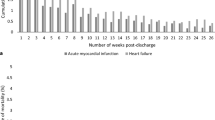Abstract
The 30-day readmission rates, predictors, and outcomes for acute heart failure (AHF) patients are well published, but data beyond 30 days and the association between readmission-free period (RFP) and in-hospital readmission-related mortality remain unknown. We queried the National Readmission Database to analyze comparative outcomes of AHF. Patients were divided into three groups based on their RFP: group 1 (1–30 days), group 2 (31–90 days), and group 3 (91–275 days). AHF cases and clinical variables were identified using ICD-9 codes. The primary outcome was in-hospital mortality at the time of readmission. A total of 39,237 unplanned readmissions occurred within 275 days; 15,181 within group 1, 11,925 within group 2, and 12,131 within group 3. In-hospital mortality in groups 1, 2, and 3 were 7.4%, 5.1%, and 4.1% (p < 0.001). Group 1 had higher percentages of patients with cardiogenic shock (1.3% vs. 0.9% vs. 0.9%; p < 0.001), acute kidney injury (30.2% vs. 25.9% vs. 24.0%; p < 0.001), dialysis use (8.6% vs. 7.5% vs. 6.9%; p < 0.001), and non-ST elevation myocardial infarction (4.4% vs. 3.8% vs. 3.6%; p < 0.001), but there was no statistical difference among the three groups for ST-elevation myocardial infarction, percutaneous coronary intervention (PCI), or ventricular assist device use at the time of index admission. However, group 3 had higher PCI (1.7%) compared with groups 1 and 2 (p < 0.001). In multivariable logistic regression, groups 2 and 3 had odd ratio of 0.70 and 0.55, respectively, for in-hospital mortality compared with group 1. Longer RFP is associated with decreased risk of in-hospital mortality at the time of first readmission.

Similar content being viewed by others
Change history
27 January 2020
The original version of this article unfortunately contained a mistake. Unfortunately, the name of one of the authors (Dr. Pradhum Ram) has been misspelled as (Prathaum Ram) instead.
References
Jencks SF, Williams MV, Coleman EA (2009) Rehospitalizations among patients in the medicare fee-for-service program. N Engl J Med. https://doi.org/10.1056/NEJMsa0803563
Zuckerman RB, Sheingold SH, Orav EJ et al (2016) Readmissions, observation, and the hospital readmissions reduction program. N Engl J Med. https://doi.org/10.1056/NEJMsa1513024
Gupta A, Allen LA, Bhatt DL et al (2018) Association of the hospital readmissions reduction program implementation with readmission and mortality outcomes in heart failure. JAMA Cardiol. https://doi.org/10.1001/jamacardio.2017.4265
Heidenreich PA, Albert NM, Allen LA et al (2013) Forecasting the impact of heart failure in the United States a policy statement from the american heart association. Circ Heart Fail. https://doi.org/10.1161/HHF.0b013e318291329a
Setoguchi S, Stevenson LW, Schneeweiss S (2007) Repeated hospitalizations predict mortality in the community population with heart failure. Am Heart J. https://doi.org/10.1016/j.ahj.2007.01.041
Healthcare Cost and Utilization Project (HCUP) (2014) HCUP National Readmissions Database (NRD). In: Agency Healthc. Res. Qual. Rockville, MD. www.hcup-us.ahrq.gov/nrdoverview.jsp. Accessed 15 Jun 2019
Patel B, Prousi G, Shah M et al (2018) Thirty-day readmission rate in acute heart failure patients discharged against medical advice in a matched cohort study. Mayo Clin Proc. https://doi.org/10.1016/j.mayocp.2018.04.023
Blecker S, Paul M, Taksler G et al (2013) Heart failure-associated hospitalizations in the United States. J Am Coll Cardiol. https://doi.org/10.1016/j.jacc.2012.12.038
Hines AL, Barrett ML, Jiang HJ, Steiner CA (2014) Conditions with the largest number of adult hospital readmissions by payer, 2011
Bergethon KE, Ju C, DeVore AD et al (2016) Trends in 30-day readmission rates for patients hospitalized with heart failure: findings from the get with the guidelines-heart failure registry. Circ Heart Fail. https://doi.org/10.1161/CIRCHEARTFAILURE.115.002594
Shaefi S, O’Gara B, Kociol RD et al (2015) Effect of cardiogenic shock hospital volume on mortality in patients with cardiogenic shock. J Am Heart Assoc. https://doi.org/10.1161/JAHA.114.001462
Shah P, Cowger JA (2014) Cardiogenic shock. Crit Care Clin
Yandrapalli S, Sanaani A, Harikrishnan P et al (2019) Cardiogenic shock during heart failure hospitalizations: age-, sex-, and race-stratified trends in incidence and outcomes. Am Heart J. https://doi.org/10.1016/j.ahj.2019.03.015
McAlister FA, Youngson E, Kaul P, Ezekowitz JA (2016) Early follow-up after a heart failure exacerbation: the importance of continuity. Circ Heart Fail. https://doi.org/10.1161/CIRCHEARTFAILURE.116.003194
Sud M, Yu B, Wijeysundera HC et al (2017) Associations between short or long length of stay and 30-day readmission and mortality in hospitalized patients with heart failure. JACC Hear Fail. https://doi.org/10.1016/j.jchf.2017.03.012
Samsky MD, Ambrosy AP, Youngson E et al (2019) Trends in readmissions and length of stay for patients hospitalized with heart failure in Canada and the United States. JAMA Cardiol. https://doi.org/10.1001/jamacardio.2019.0766
Vader JM, LaRue SJ, Stevens SR et al (2016) Timing and causes of readmission after acute heart failure hospitalization—insights from the heart failure network trials. J Card Fail. https://doi.org/10.1016/j.cardfail.2016.04.014
Joynt KE, Orav EJ, Jha AK (2011) Thirty-day readmission rates for medicare beneficiaries by race and site of care. JAMA - J Am Med Assoc. https://doi.org/10.1001/jama.2011.123
McCormick N, Lacaille D, Bhole V, Avina-Zubieta JA (2014) Validity of heart failure diagnoses in administrative databases: a systematic review and meta-analysis. PLoS One
Author information
Authors and Affiliations
Corresponding author
Ethics declarations
Conflict of interest
The authors declare that they have no conflict of interest.
Additional information
Publisher’s note
Springer Nature remains neutral with regard to jurisdictional claims in published maps and institutional affiliations.
The original version of this article was revised: The name of the author was misspelled from "Prathaum Ram" and should be "Pradhum Ram".
Rights and permissions
About this article
Cite this article
Altibi, A.M., Prousi, G., Agarwal, M. et al. Readmission-free period and in-hospital mortality at the time of first readmission in acute heart failure patients—NRD-based analysis of 40,000 heart failure readmissions. Heart Fail Rev 26, 57–64 (2021). https://doi.org/10.1007/s10741-019-09912-z
Published:
Issue Date:
DOI: https://doi.org/10.1007/s10741-019-09912-z




